Living Wage and Minimum Wage: A Comparative Analysis
VerifiedAdded on 2022/12/30
|8
|2236
|35
AI Summary
This report discusses the concepts of living wage and minimum wage, their impact on workers and the economy, and the implementation of these wages worldwide.
Contribute Materials
Your contribution can guide someone’s learning journey. Share your
documents today.
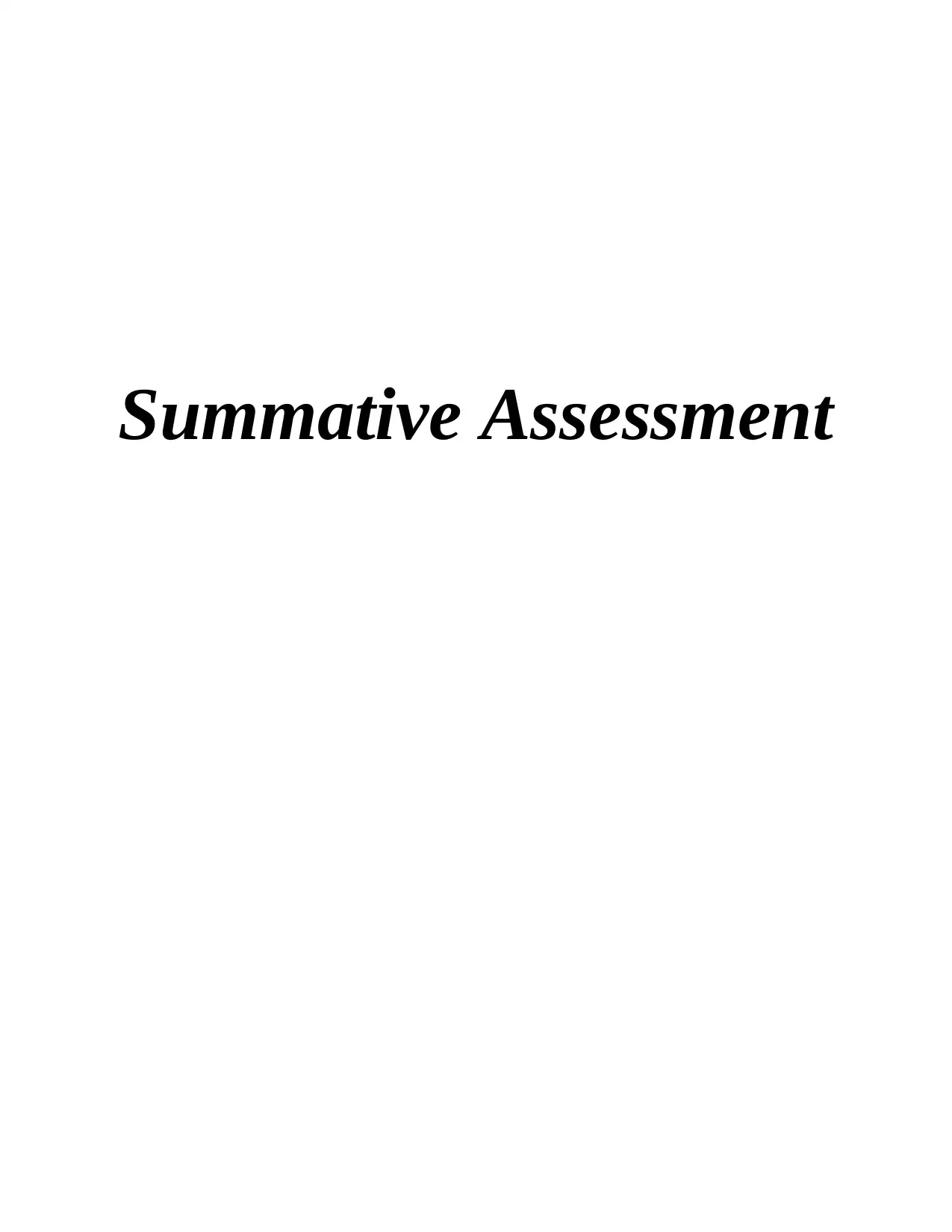
Summative Assessment
Secure Best Marks with AI Grader
Need help grading? Try our AI Grader for instant feedback on your assignments.
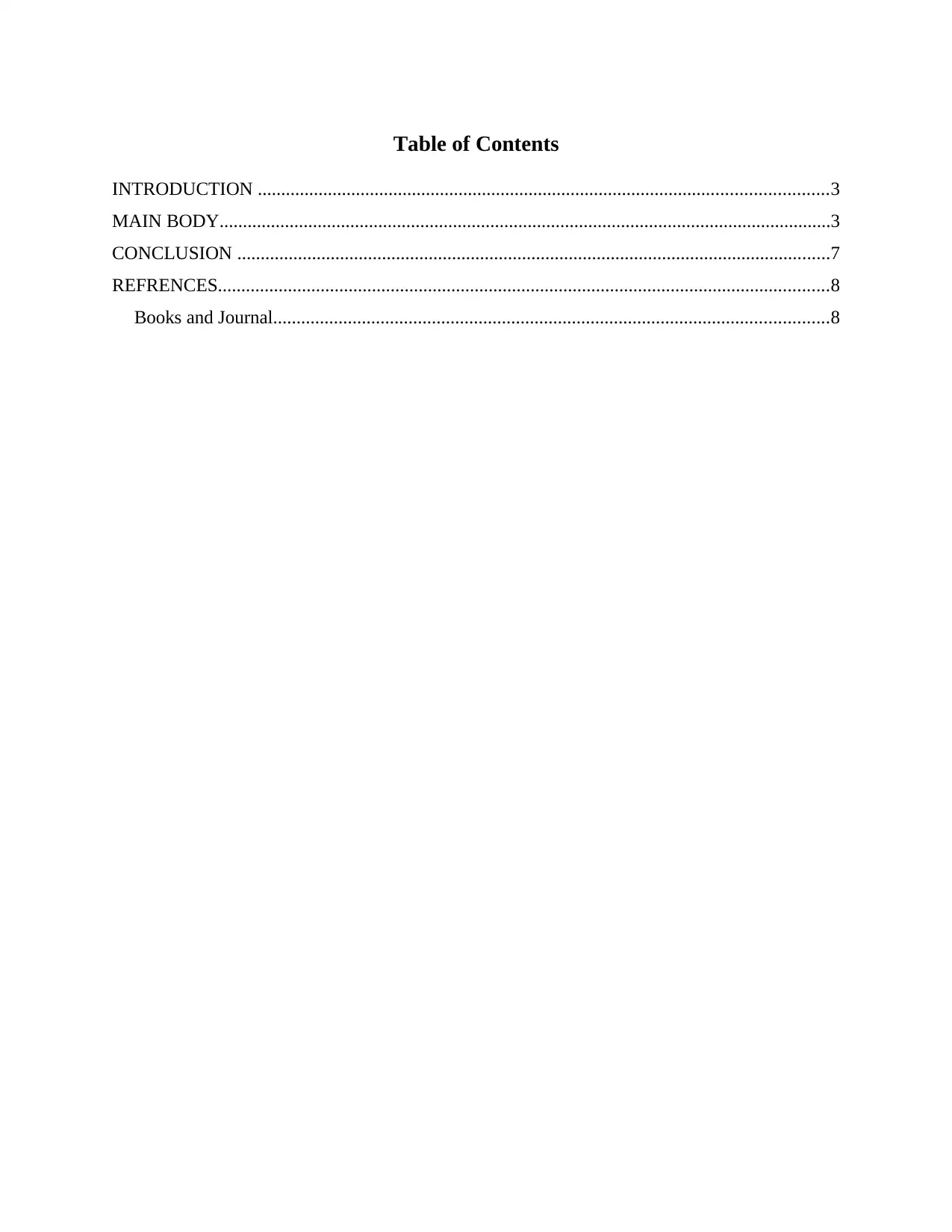
Table of Contents
INTRODUCTION ..........................................................................................................................3
MAIN BODY...................................................................................................................................3
CONCLUSION ...............................................................................................................................7
REFRENCES...................................................................................................................................8
Books and Journal.......................................................................................................................8
INTRODUCTION ..........................................................................................................................3
MAIN BODY...................................................................................................................................3
CONCLUSION ...............................................................................................................................7
REFRENCES...................................................................................................................................8
Books and Journal.......................................................................................................................8
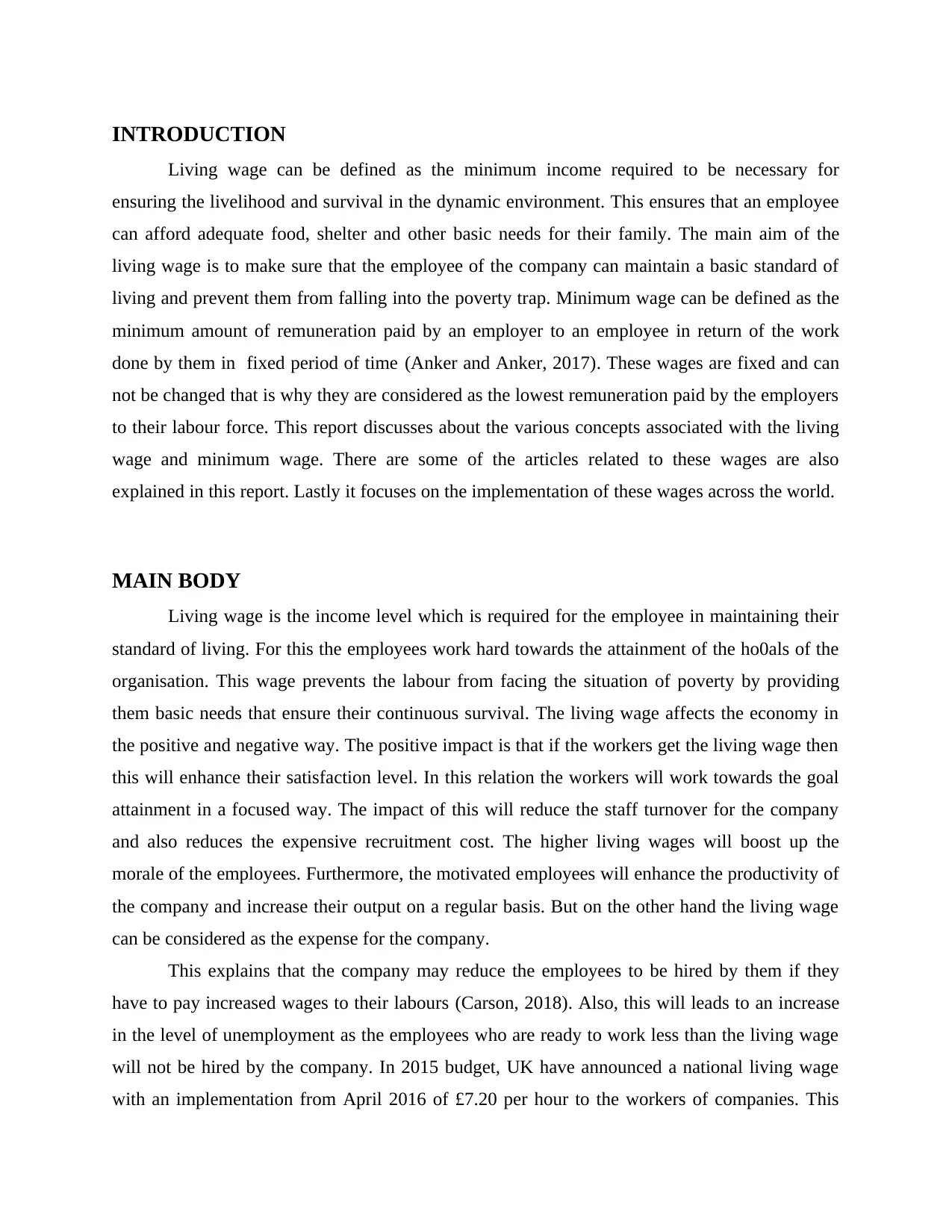
INTRODUCTION
Living wage can be defined as the minimum income required to be necessary for
ensuring the livelihood and survival in the dynamic environment. This ensures that an employee
can afford adequate food, shelter and other basic needs for their family. The main aim of the
living wage is to make sure that the employee of the company can maintain a basic standard of
living and prevent them from falling into the poverty trap. Minimum wage can be defined as the
minimum amount of remuneration paid by an employer to an employee in return of the work
done by them in fixed period of time (Anker and Anker, 2017). These wages are fixed and can
not be changed that is why they are considered as the lowest remuneration paid by the employers
to their labour force. This report discusses about the various concepts associated with the living
wage and minimum wage. There are some of the articles related to these wages are also
explained in this report. Lastly it focuses on the implementation of these wages across the world.
MAIN BODY
Living wage is the income level which is required for the employee in maintaining their
standard of living. For this the employees work hard towards the attainment of the ho0als of the
organisation. This wage prevents the labour from facing the situation of poverty by providing
them basic needs that ensure their continuous survival. The living wage affects the economy in
the positive and negative way. The positive impact is that if the workers get the living wage then
this will enhance their satisfaction level. In this relation the workers will work towards the goal
attainment in a focused way. The impact of this will reduce the staff turnover for the company
and also reduces the expensive recruitment cost. The higher living wages will boost up the
morale of the employees. Furthermore, the motivated employees will enhance the productivity of
the company and increase their output on a regular basis. But on the other hand the living wage
can be considered as the expense for the company.
This explains that the company may reduce the employees to be hired by them if they
have to pay increased wages to their labours (Carson, 2018). Also, this will leads to an increase
in the level of unemployment as the employees who are ready to work less than the living wage
will not be hired by the company. In 2015 budget, UK have announced a national living wage
with an implementation from April 2016 of £7.20 per hour to the workers of companies. This
Living wage can be defined as the minimum income required to be necessary for
ensuring the livelihood and survival in the dynamic environment. This ensures that an employee
can afford adequate food, shelter and other basic needs for their family. The main aim of the
living wage is to make sure that the employee of the company can maintain a basic standard of
living and prevent them from falling into the poverty trap. Minimum wage can be defined as the
minimum amount of remuneration paid by an employer to an employee in return of the work
done by them in fixed period of time (Anker and Anker, 2017). These wages are fixed and can
not be changed that is why they are considered as the lowest remuneration paid by the employers
to their labour force. This report discusses about the various concepts associated with the living
wage and minimum wage. There are some of the articles related to these wages are also
explained in this report. Lastly it focuses on the implementation of these wages across the world.
MAIN BODY
Living wage is the income level which is required for the employee in maintaining their
standard of living. For this the employees work hard towards the attainment of the ho0als of the
organisation. This wage prevents the labour from facing the situation of poverty by providing
them basic needs that ensure their continuous survival. The living wage affects the economy in
the positive and negative way. The positive impact is that if the workers get the living wage then
this will enhance their satisfaction level. In this relation the workers will work towards the goal
attainment in a focused way. The impact of this will reduce the staff turnover for the company
and also reduces the expensive recruitment cost. The higher living wages will boost up the
morale of the employees. Furthermore, the motivated employees will enhance the productivity of
the company and increase their output on a regular basis. But on the other hand the living wage
can be considered as the expense for the company.
This explains that the company may reduce the employees to be hired by them if they
have to pay increased wages to their labours (Carson, 2018). Also, this will leads to an increase
in the level of unemployment as the employees who are ready to work less than the living wage
will not be hired by the company. In 2015 budget, UK have announced a national living wage
with an implementation from April 2016 of £7.20 per hour to the workers of companies. This
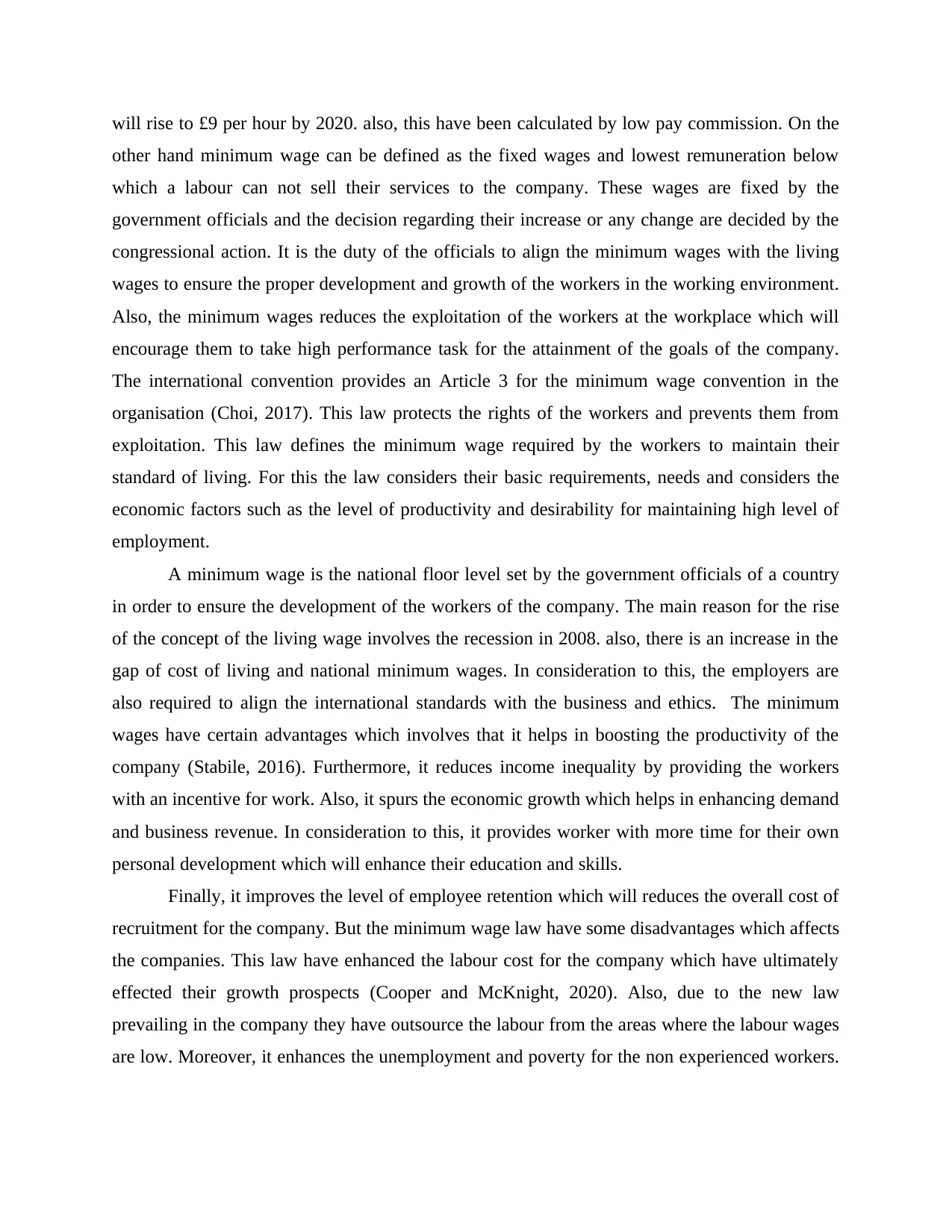
will rise to £9 per hour by 2020. also, this have been calculated by low pay commission. On the
other hand minimum wage can be defined as the fixed wages and lowest remuneration below
which a labour can not sell their services to the company. These wages are fixed by the
government officials and the decision regarding their increase or any change are decided by the
congressional action. It is the duty of the officials to align the minimum wages with the living
wages to ensure the proper development and growth of the workers in the working environment.
Also, the minimum wages reduces the exploitation of the workers at the workplace which will
encourage them to take high performance task for the attainment of the goals of the company.
The international convention provides an Article 3 for the minimum wage convention in the
organisation (Choi, 2017). This law protects the rights of the workers and prevents them from
exploitation. This law defines the minimum wage required by the workers to maintain their
standard of living. For this the law considers their basic requirements, needs and considers the
economic factors such as the level of productivity and desirability for maintaining high level of
employment.
A minimum wage is the national floor level set by the government officials of a country
in order to ensure the development of the workers of the company. The main reason for the rise
of the concept of the living wage involves the recession in 2008. also, there is an increase in the
gap of cost of living and national minimum wages. In consideration to this, the employers are
also required to align the international standards with the business and ethics. The minimum
wages have certain advantages which involves that it helps in boosting the productivity of the
company (Stabile, 2016). Furthermore, it reduces income inequality by providing the workers
with an incentive for work. Also, it spurs the economic growth which helps in enhancing demand
and business revenue. In consideration to this, it provides worker with more time for their own
personal development which will enhance their education and skills.
Finally, it improves the level of employee retention which will reduces the overall cost of
recruitment for the company. But the minimum wage law have some disadvantages which affects
the companies. This law have enhanced the labour cost for the company which have ultimately
effected their growth prospects (Cooper and McKnight, 2020). Also, due to the new law
prevailing in the company they have outsource the labour from the areas where the labour wages
are low. Moreover, it enhances the unemployment and poverty for the non experienced workers.
other hand minimum wage can be defined as the fixed wages and lowest remuneration below
which a labour can not sell their services to the company. These wages are fixed by the
government officials and the decision regarding their increase or any change are decided by the
congressional action. It is the duty of the officials to align the minimum wages with the living
wages to ensure the proper development and growth of the workers in the working environment.
Also, the minimum wages reduces the exploitation of the workers at the workplace which will
encourage them to take high performance task for the attainment of the goals of the company.
The international convention provides an Article 3 for the minimum wage convention in the
organisation (Choi, 2017). This law protects the rights of the workers and prevents them from
exploitation. This law defines the minimum wage required by the workers to maintain their
standard of living. For this the law considers their basic requirements, needs and considers the
economic factors such as the level of productivity and desirability for maintaining high level of
employment.
A minimum wage is the national floor level set by the government officials of a country
in order to ensure the development of the workers of the company. The main reason for the rise
of the concept of the living wage involves the recession in 2008. also, there is an increase in the
gap of cost of living and national minimum wages. In consideration to this, the employers are
also required to align the international standards with the business and ethics. The minimum
wages have certain advantages which involves that it helps in boosting the productivity of the
company (Stabile, 2016). Furthermore, it reduces income inequality by providing the workers
with an incentive for work. Also, it spurs the economic growth which helps in enhancing demand
and business revenue. In consideration to this, it provides worker with more time for their own
personal development which will enhance their education and skills.
Finally, it improves the level of employee retention which will reduces the overall cost of
recruitment for the company. But the minimum wage law have some disadvantages which affects
the companies. This law have enhanced the labour cost for the company which have ultimately
effected their growth prospects (Cooper and McKnight, 2020). Also, due to the new law
prevailing in the company they have outsource the labour from the areas where the labour wages
are low. Moreover, it enhances the unemployment and poverty for the non experienced workers.
Secure Best Marks with AI Grader
Need help grading? Try our AI Grader for instant feedback on your assignments.
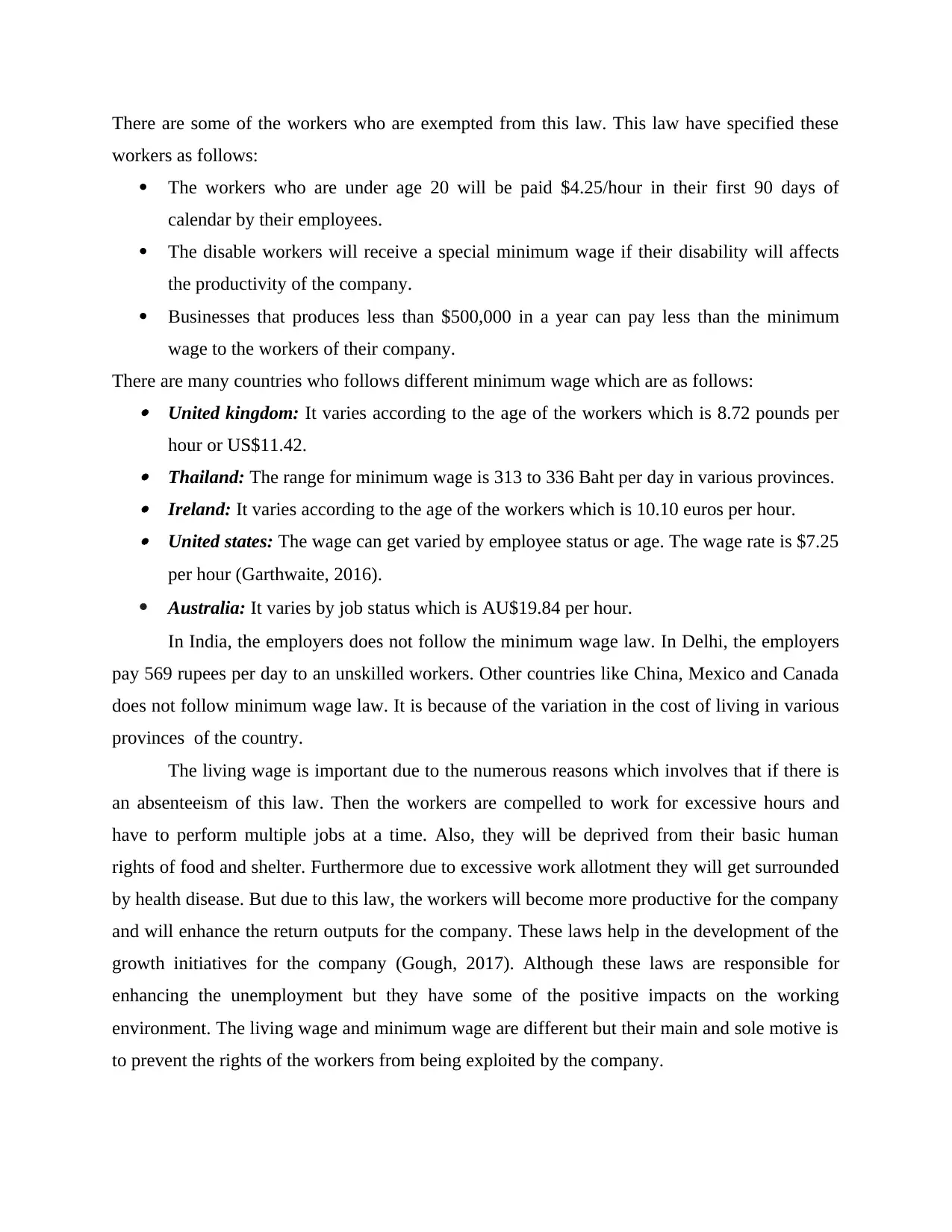
There are some of the workers who are exempted from this law. This law have specified these
workers as follows:
The workers who are under age 20 will be paid $4.25/hour in their first 90 days of
calendar by their employees.
The disable workers will receive a special minimum wage if their disability will affects
the productivity of the company.
Businesses that produces less than $500,000 in a year can pay less than the minimum
wage to the workers of their company.
There are many countries who follows different minimum wage which are as follows: United kingdom: It varies according to the age of the workers which is 8.72 pounds per
hour or US$11.42. Thailand: The range for minimum wage is 313 to 336 Baht per day in various provinces. Ireland: It varies according to the age of the workers which is 10.10 euros per hour. United states: The wage can get varied by employee status or age. The wage rate is $7.25
per hour (Garthwaite, 2016).
Australia: It varies by job status which is AU$19.84 per hour.
In India, the employers does not follow the minimum wage law. In Delhi, the employers
pay 569 rupees per day to an unskilled workers. Other countries like China, Mexico and Canada
does not follow minimum wage law. It is because of the variation in the cost of living in various
provinces of the country.
The living wage is important due to the numerous reasons which involves that if there is
an absenteeism of this law. Then the workers are compelled to work for excessive hours and
have to perform multiple jobs at a time. Also, they will be deprived from their basic human
rights of food and shelter. Furthermore due to excessive work allotment they will get surrounded
by health disease. But due to this law, the workers will become more productive for the company
and will enhance the return outputs for the company. These laws help in the development of the
growth initiatives for the company (Gough, 2017). Although these laws are responsible for
enhancing the unemployment but they have some of the positive impacts on the working
environment. The living wage and minimum wage are different but their main and sole motive is
to prevent the rights of the workers from being exploited by the company.
workers as follows:
The workers who are under age 20 will be paid $4.25/hour in their first 90 days of
calendar by their employees.
The disable workers will receive a special minimum wage if their disability will affects
the productivity of the company.
Businesses that produces less than $500,000 in a year can pay less than the minimum
wage to the workers of their company.
There are many countries who follows different minimum wage which are as follows: United kingdom: It varies according to the age of the workers which is 8.72 pounds per
hour or US$11.42. Thailand: The range for minimum wage is 313 to 336 Baht per day in various provinces. Ireland: It varies according to the age of the workers which is 10.10 euros per hour. United states: The wage can get varied by employee status or age. The wage rate is $7.25
per hour (Garthwaite, 2016).
Australia: It varies by job status which is AU$19.84 per hour.
In India, the employers does not follow the minimum wage law. In Delhi, the employers
pay 569 rupees per day to an unskilled workers. Other countries like China, Mexico and Canada
does not follow minimum wage law. It is because of the variation in the cost of living in various
provinces of the country.
The living wage is important due to the numerous reasons which involves that if there is
an absenteeism of this law. Then the workers are compelled to work for excessive hours and
have to perform multiple jobs at a time. Also, they will be deprived from their basic human
rights of food and shelter. Furthermore due to excessive work allotment they will get surrounded
by health disease. But due to this law, the workers will become more productive for the company
and will enhance the return outputs for the company. These laws help in the development of the
growth initiatives for the company (Gough, 2017). Although these laws are responsible for
enhancing the unemployment but they have some of the positive impacts on the working
environment. The living wage and minimum wage are different but their main and sole motive is
to prevent the rights of the workers from being exploited by the company.
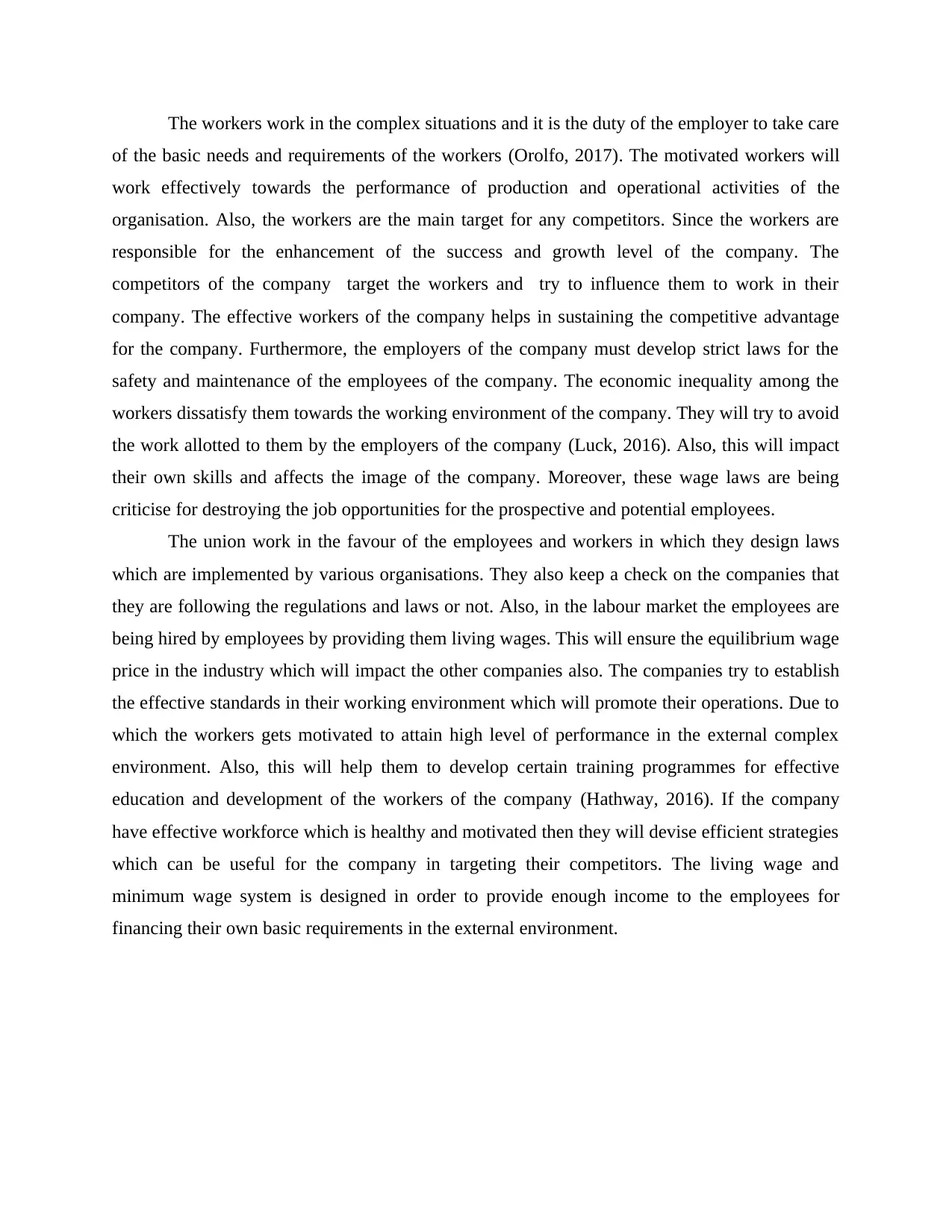
The workers work in the complex situations and it is the duty of the employer to take care
of the basic needs and requirements of the workers (Orolfo, 2017). The motivated workers will
work effectively towards the performance of production and operational activities of the
organisation. Also, the workers are the main target for any competitors. Since the workers are
responsible for the enhancement of the success and growth level of the company. The
competitors of the company target the workers and try to influence them to work in their
company. The effective workers of the company helps in sustaining the competitive advantage
for the company. Furthermore, the employers of the company must develop strict laws for the
safety and maintenance of the employees of the company. The economic inequality among the
workers dissatisfy them towards the working environment of the company. They will try to avoid
the work allotted to them by the employers of the company (Luck, 2016). Also, this will impact
their own skills and affects the image of the company. Moreover, these wage laws are being
criticise for destroying the job opportunities for the prospective and potential employees.
The union work in the favour of the employees and workers in which they design laws
which are implemented by various organisations. They also keep a check on the companies that
they are following the regulations and laws or not. Also, in the labour market the employees are
being hired by employees by providing them living wages. This will ensure the equilibrium wage
price in the industry which will impact the other companies also. The companies try to establish
the effective standards in their working environment which will promote their operations. Due to
which the workers gets motivated to attain high level of performance in the external complex
environment. Also, this will help them to develop certain training programmes for effective
education and development of the workers of the company (Hathway, 2016). If the company
have effective workforce which is healthy and motivated then they will devise efficient strategies
which can be useful for the company in targeting their competitors. The living wage and
minimum wage system is designed in order to provide enough income to the employees for
financing their own basic requirements in the external environment.
of the basic needs and requirements of the workers (Orolfo, 2017). The motivated workers will
work effectively towards the performance of production and operational activities of the
organisation. Also, the workers are the main target for any competitors. Since the workers are
responsible for the enhancement of the success and growth level of the company. The
competitors of the company target the workers and try to influence them to work in their
company. The effective workers of the company helps in sustaining the competitive advantage
for the company. Furthermore, the employers of the company must develop strict laws for the
safety and maintenance of the employees of the company. The economic inequality among the
workers dissatisfy them towards the working environment of the company. They will try to avoid
the work allotted to them by the employers of the company (Luck, 2016). Also, this will impact
their own skills and affects the image of the company. Moreover, these wage laws are being
criticise for destroying the job opportunities for the prospective and potential employees.
The union work in the favour of the employees and workers in which they design laws
which are implemented by various organisations. They also keep a check on the companies that
they are following the regulations and laws or not. Also, in the labour market the employees are
being hired by employees by providing them living wages. This will ensure the equilibrium wage
price in the industry which will impact the other companies also. The companies try to establish
the effective standards in their working environment which will promote their operations. Due to
which the workers gets motivated to attain high level of performance in the external complex
environment. Also, this will help them to develop certain training programmes for effective
education and development of the workers of the company (Hathway, 2016). If the company
have effective workforce which is healthy and motivated then they will devise efficient strategies
which can be useful for the company in targeting their competitors. The living wage and
minimum wage system is designed in order to provide enough income to the employees for
financing their own basic requirements in the external environment.
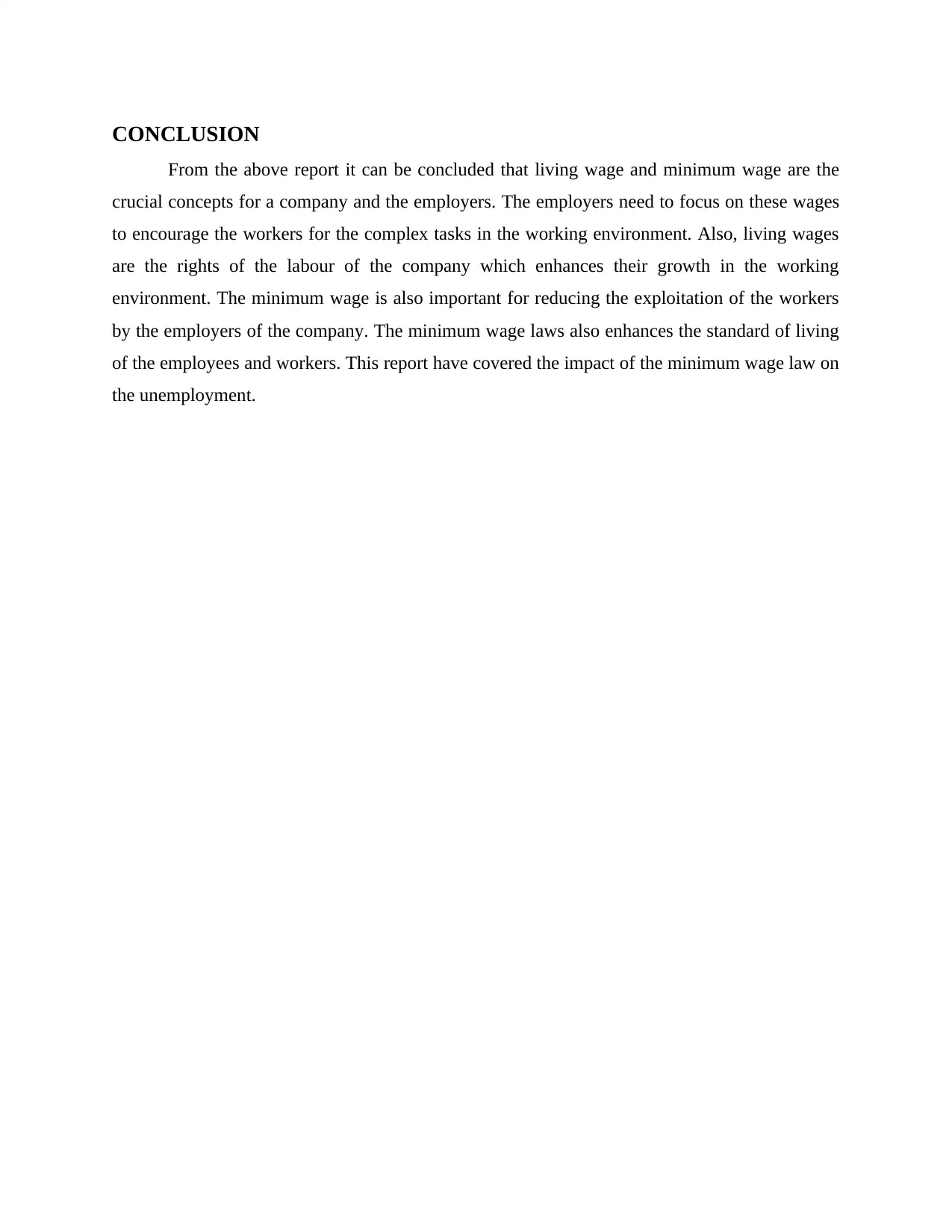
CONCLUSION
From the above report it can be concluded that living wage and minimum wage are the
crucial concepts for a company and the employers. The employers need to focus on these wages
to encourage the workers for the complex tasks in the working environment. Also, living wages
are the rights of the labour of the company which enhances their growth in the working
environment. The minimum wage is also important for reducing the exploitation of the workers
by the employers of the company. The minimum wage laws also enhances the standard of living
of the employees and workers. This report have covered the impact of the minimum wage law on
the unemployment.
From the above report it can be concluded that living wage and minimum wage are the
crucial concepts for a company and the employers. The employers need to focus on these wages
to encourage the workers for the complex tasks in the working environment. Also, living wages
are the rights of the labour of the company which enhances their growth in the working
environment. The minimum wage is also important for reducing the exploitation of the workers
by the employers of the company. The minimum wage laws also enhances the standard of living
of the employees and workers. This report have covered the impact of the minimum wage law on
the unemployment.
Paraphrase This Document
Need a fresh take? Get an instant paraphrase of this document with our AI Paraphraser
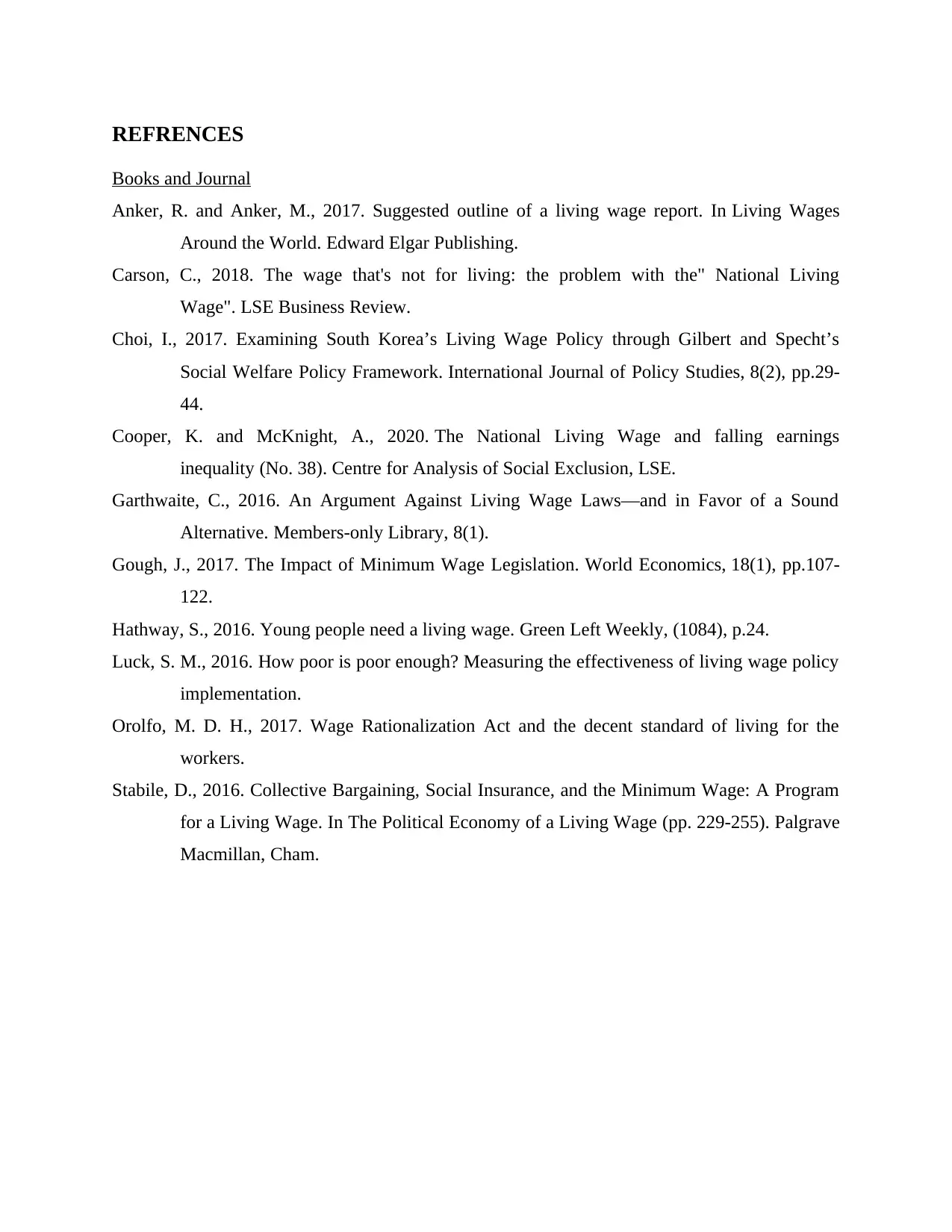
REFRENCES
Books and Journal
Anker, R. and Anker, M., 2017. Suggested outline of a living wage report. In Living Wages
Around the World. Edward Elgar Publishing.
Carson, C., 2018. The wage that's not for living: the problem with the" National Living
Wage". LSE Business Review.
Choi, I., 2017. Examining South Korea’s Living Wage Policy through Gilbert and Specht’s
Social Welfare Policy Framework. International Journal of Policy Studies, 8(2), pp.29-
44.
Cooper, K. and McKnight, A., 2020. The National Living Wage and falling earnings
inequality (No. 38). Centre for Analysis of Social Exclusion, LSE.
Garthwaite, C., 2016. An Argument Against Living Wage Laws—and in Favor of a Sound
Alternative. Members-only Library, 8(1).
Gough, J., 2017. The Impact of Minimum Wage Legislation. World Economics, 18(1), pp.107-
122.
Hathway, S., 2016. Young people need a living wage. Green Left Weekly, (1084), p.24.
Luck, S. M., 2016. How poor is poor enough? Measuring the effectiveness of living wage policy
implementation.
Orolfo, M. D. H., 2017. Wage Rationalization Act and the decent standard of living for the
workers.
Stabile, D., 2016. Collective Bargaining, Social Insurance, and the Minimum Wage: A Program
for a Living Wage. In The Political Economy of a Living Wage (pp. 229-255). Palgrave
Macmillan, Cham.
Books and Journal
Anker, R. and Anker, M., 2017. Suggested outline of a living wage report. In Living Wages
Around the World. Edward Elgar Publishing.
Carson, C., 2018. The wage that's not for living: the problem with the" National Living
Wage". LSE Business Review.
Choi, I., 2017. Examining South Korea’s Living Wage Policy through Gilbert and Specht’s
Social Welfare Policy Framework. International Journal of Policy Studies, 8(2), pp.29-
44.
Cooper, K. and McKnight, A., 2020. The National Living Wage and falling earnings
inequality (No. 38). Centre for Analysis of Social Exclusion, LSE.
Garthwaite, C., 2016. An Argument Against Living Wage Laws—and in Favor of a Sound
Alternative. Members-only Library, 8(1).
Gough, J., 2017. The Impact of Minimum Wage Legislation. World Economics, 18(1), pp.107-
122.
Hathway, S., 2016. Young people need a living wage. Green Left Weekly, (1084), p.24.
Luck, S. M., 2016. How poor is poor enough? Measuring the effectiveness of living wage policy
implementation.
Orolfo, M. D. H., 2017. Wage Rationalization Act and the decent standard of living for the
workers.
Stabile, D., 2016. Collective Bargaining, Social Insurance, and the Minimum Wage: A Program
for a Living Wage. In The Political Economy of a Living Wage (pp. 229-255). Palgrave
Macmillan, Cham.
1 out of 8
Related Documents
Your All-in-One AI-Powered Toolkit for Academic Success.
+13062052269
info@desklib.com
Available 24*7 on WhatsApp / Email
![[object Object]](/_next/static/media/star-bottom.7253800d.svg)
Unlock your academic potential
© 2024 | Zucol Services PVT LTD | All rights reserved.





